Condensed from Lachish.org, and adapted by Bro. Vince Kluth
King Sennacherib constructed a “Palace Without Rival” at his new capital city Nineveh where he chronicled his battlefield successes. One building’s inner space was accessible only by the family and senior court officials. Immense guardian figures loomed over a passageway leading to 8’ high by 80’ long battle scenes carved on the walls. Sir Austen H. Layard discovered and sent them to the British Museum in 1851 (see below). These bas-relief panels were meant to impress foreign emissaries and dignitaries awaiting an audience with the king, and to warn those close to him of the king’s absolute control.
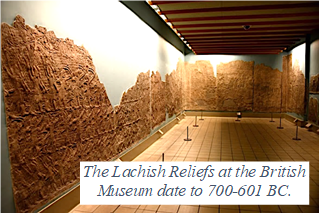
The events depicted took place in 701 BC during the king’s third campaign along the Phoenician coasts and against the cities of Philistia and Judea, during which he defeated the Egyptian army and laid siege to King Hezekiah’s defense cities near Jerusalem. Isaiah chapter 36 chronicles his attack while Sennacherib’s successes against Lachish are recounted on stone and clay cylinders and prisms found at Nineveh, providing unique correlation among the biblical texts, contemporary Assyrian documents and excavated evidence.
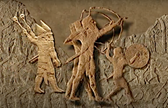 Starting from the left, one views rows of Assyrian archers, slingers and spearmen (emphasized, left) moving toward the city.
Starting from the left, one views rows of Assyrian archers, slingers and spearmen (emphasized, left) moving toward the city.
Lachish is depicted as a hilltop fortress, having double side walls with turrets and battlements with square windows (colored, below). All these features have been verified through excavations at tel Lachish.
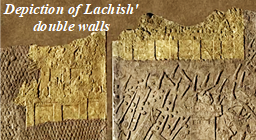
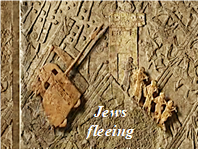 As townspeople flee the city down the roadway leading from the town gate, Lachish is attacked by Assyrian siege engines and ramps (see left). This huge ramp has actually been found against the walls of the city ruins (see below).
As townspeople flee the city down the roadway leading from the town gate, Lachish is attacked by Assyrian siege engines and ramps (see left). This huge ramp has actually been found against the walls of the city ruins (see below).

The next battle scene shows prisoners, deportees and captured goods brought before Sennacherib, who is seated at his command post (see below) on a neighboring hilltop where the king oversaw the destruction of Lachish. The cuneiform inscription (red box, inset) tells us “Sennacherib, king of the world, king of Assyria, set up a throne while the booty of Lachish passed before him.” Note that his face has been chipped out, presumably by a later adversary. At the foot of the hill (not shown here), the king’s chariot awaits along with a line of soldiers and booty that includes symbols of state, such as the governor’s thrones, his chariot and scepter. It’s perhaps from this campsite throne that Sennacherib received the message sent by Hezekiah then huddled in a besieged Jerusalem and mentioned in 2 Kings 18:14, Hezekiah king of Judah sent to the king of Assyria to Lachish, saying, I have offended; return from me: that which thou puttest on me will I bear. The biblical passage then tells us that Sennacherib accepted heavy tribute from Hezekiah.
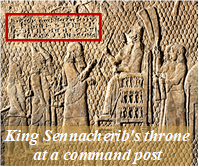
However, what’s most telling is what’s missing; namely, the king could only brag about taking Judah’s number 2 city, not the capital of Jerusalem. Though his mighty army surrounded Jerusalem, he didn’t count on one angel destroying 185,000 of his men. On the Sennacherib cylinder, he boasts “Hezekiah the Judahite I shut up like a caged bird in Jerusalem”. Another clay cylinder notes his death by one son, but Isaiah 37:38 says both. Seems to me that God’s record is more truthful.
Sources: Lachish.org, ThinkingToBelieve.com.
Like this? Consider sharing it to Facebook by clicking the linked icon below.
